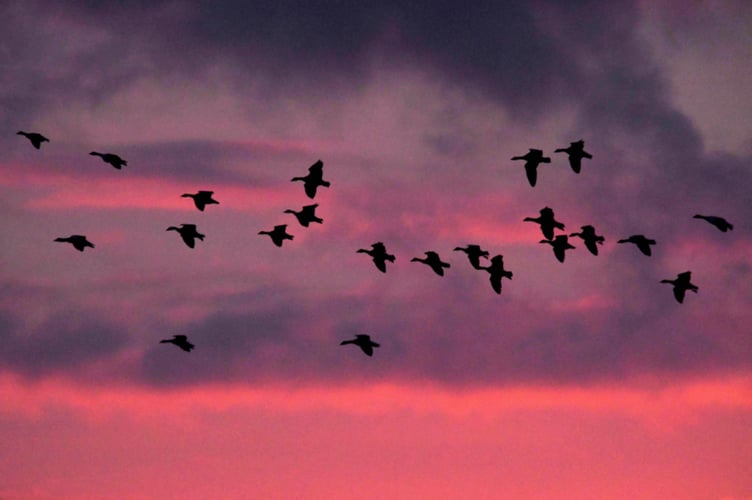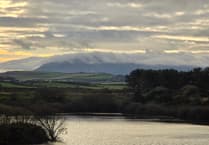Concern is growing over the proliferation of greylag, or feral, geese in the island. Their numbers even threaten to derail current schemes to improve the environment for other wildlife. Stand at the Point of Ayre just as it’s going dark and you are likely to see them flying in from other parts of the island to spend the night.
’They are coming in in waves and it’s quite a spectacle. And if they were meant to be there it would be wonderful because they’re a great thing to see,’ says David Bellamy of the Manx Wildlife Trust.
But he, along with increasing numbers of farmers and other conservationists, are growing ever more concerned at the damage these birds are doing, both to crops and to the wider environment.
Kevin Kinrade, who farms beef and sheep on the north eastern coast of the island, at Ballaquark in Bride, says that he has given up growing winter barley because of the damage to the crop inflicted by the greylag geese.
He says: ’I always grew my own barley for feeding the cattle in the wintertime. Now I’ve stopped and I’m buying it in because I just got hassled with the geese.
’I was growing barley for probably 20 years and, in the last six to eight years I’ve started having problems with the geese, especially in the fields that aren’t close to the house. They don’t like coming around where there’s activity.
’I used to grow it in some fields which are right out on the edge of the cliff and the problem I found with them was they would come in at night, maybe just on the edge of dark, land in the field and they’d be gone in the morning by the time you’d get up. You don’t even know they’re there but three or four hundred of them on a field of barley can virtually wipe it out in a night.’
As is sometimes the case with conservation and environmental initiatives, these can have unintended consequences, so schemes that were meant to help our Red List birds to re-establish themselves on the island have also created the perfect conditions for the Greylag to dramatically increase its numbers.
They have inadvertently created the perfect conditions for the greylag to thrive and that is harming both farmers’ livelihoods and other species.
David Bellamy says: ’Ironically we’ve got to the stage where they’ve taken a liking to the old gravel pits which are now lakes at the Point of Ayre, which Manx Birdlife run. Those pits have been legally protected as a special area for birds so you’re not allowed to shoot any of them.’
Kevin agrees: ’Yes, we’ve got a sanctuary where no one can get near them.’
In addition, the new Agri Environment Scheme (AES) is encouraging farmers to put dubs in their fields, ostensibly to help Red List birds like the curlew, but greylag geese also like to nest near water.
The greylag is not even a native species to the Isle of Man, as David explains: ’They are classed as ’an irregular winter visitor’, rather than one of our native birds however in the late 70s they started being found as residents.
’It has never been proved, as far as I’m aware, but there was an assumption that they’d escaped from the Wildlife Park, like the wallabies.
’The numbers have been going up each year. The problem’s getting worse: they are a major agricultural pest and no one’s done anything about it.
’If we were having this meeting 30 years ago it would have been such an easy thing to solve but the greylags may have become uncontrollable now. It may be too late to do anything.’
Unfortunately for Kevin, his farm is close to the gravel pits but the problem has spread to other areas on the island. The greylag have always flown over the northern plain, between the Ayres and the Ballaugh Curraghs, and can be found in all those areas, and even as far east as Laxey, but now there are reckoned to be around 300 on the Malew plain in the south of the island.
David says: ’My concern there is you’ve got the airport and it was geese that took down an aircraft on the Hudson in 2009, so it’s not just an agricultural and wildlife concern but maybe an air safety one as well.’
When it comes to wildlife, the greylags are potentially preventing other species who like to live in dubs, on farmland, such as the Red Listed curlew, from re-establishing themselves on the Isle of Man.
David says: ’Everything they eat could be there for other species to eat. That could be available for our native struggling farmland birds.’
The Isle of Man Government has recognised that the greylag numbers need to be controlled and will issue licences for them to be shot in unprotected areas of the island, but they are not an easy bird to get near enough to shoot so this is unlikely to reduce the numbers significantly.
Sarah Comish, secretary of the Manx NFU says: ’From the Union’s point of view we’d always support any control methods of any species that’s having such a negative impact on farms.’
Kevin says it’s hard to quantify what it is costing him having to buy in barley, given the way the price of both fertiliser and feed is continuing to rise.
He says: ’It’s inconvenient and the price of barley only seems to be going one way but the price of everything has just rocketed.
’The fact that I can’t grow barley is not the be all and end all because, OK I’m not growing 20-30 acres of barley but I know have 20-30 acres more grass so I cut more silage. That’s not necessarily the biggest situation but they are doing considerable damage and they eat grass as well, it’s not just winter crops, and grass is an expensive crop.
’From my point of view it’s just when do we get to a number when people say: "OK there’s enough of them now".’


.jpeg?width=209&height=140&crop=209:145,smart&quality=75)


Comments
This article has no comments yet. Be the first to leave a comment.